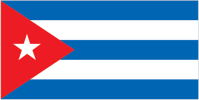Compare
San Marino
to
Cubato
Cuba510 in every 100,000 people are currently imprisoned in Cuba compared to 6 in San Marino
This entry contains the number of people in penal institutions, including pre-trial detainees. Comparability is hampered by differences in local practice, including whether psychiatrically ill offenders are under the authority of the prison administration. People held in a form of custody not under the authority of a prison administration are not included in this figure.
Source:
International Centre for Prison Studies
Cuba has an unemployment rate of 2.70% while San Marino has 8.70%
This entry contains the percent of the labor force that is without jobs.
Source:
CIA World Factbook
The life expectancy at birth in Cuba is 78.22 while in San Marino it is 83.18.
This entry contains the average number of years to be lived by a group of people born in the same year, if mortality at each age remains constant in the future. The entry includes total population as well as the male and female components. Life expectancy at birth is also a measure of overall quality of life in a country and summarizes the mortality at all ages. It can also be thought of as indicating the potential return on investment in human capital and is necessary for the calculation of various actuarial measures.
Source:
CIA World Factbook
Per capita public and private health expenditures combined in Cuba are $558.30 USD while San Marino spends $3,791.80 USD
This entry contains the per capita public and private health expenditure at purchase power parity using US Dollars. This figure combines government, personal, and employer spending on health care
Source:
World Health Organization
The number of deaths of infants under one year old in a given year per 1,000 live births in Cuba is 4.70 while in San Marino it is 4.52.
This entry gives the number of deaths of infants under one year old in a given year per 1,000 live births in the same year; included is the total death rate, and deaths by sex, male and female. This rate is often used as an indicator of the level of health in a country.
Source:
CIA World Factbook
The annual number of births per 1,000 people in Cuba is 9.90 while in San Marino it is 8.70.
This entry gives the average annual number of births during a year per 1,000 persons in the population at midyear; also known as crude birth rate. The birth rate is usually the dominant factor in determining the rate of population growth. It depends on both the level of fertility and the age structure of the population.
Source:
CIA World Factbook
 With its 11,047,251 people, Cuba is the
77th largest country in the world by
population. It is the 106th largest country in the
world by area with 110,860 square kilometers.
With its 11,047,251 people, Cuba is the
77th largest country in the world by
population. It is the 106th largest country in the
world by area with 110,860 square kilometers.
The native Amerindian population of Cuba began to decline after the European discovery of the island by Christopher COLUMBUS in 1492 and following its development as a Spanish colony during the next several centuries. Large numbers of African slaves were imported to work the coffee and sugar plantations, and Havana became the launching point for the annual treasure fleets bound for Spain from Mexico and Peru. Spanish rule eventually provoked an independence movement and occasional rebellions that were harshly suppressed. US intervention during the Spanish-American War in 1898 assisted the Cubans in overthrowing Spanish rule. Subsequently, the 1901 Platt Amendment to the Cuban constitution authorized the US to intevene in Cuba in the event of instability. The Treaty of Paris established Cuban independence from the US in 1902 after which the island experienced a string of governments mostly dominated by the military and corrupt politicians. Fidel CASTRO led a rebel army to victory in 1959; his iron rule held the subsequent regime together for nearly five decades. He stepped down as president in February 2008 in favor of his younger brother Raul CASTRO. Cuba's communist revolution, with Soviet support, was exported throughout Latin America and Africa during the 1960s, 1970s, and 1980s. The country faced a severe economic downturn in 1990 following the withdrawal of former Soviet subsidies worth $4-6 billion annually. Cuba at times portrays the US embargo, in place since 1961, as the source if its difficulties. Illicit migration to the US - using homemade rafts, alien smugglers, air flights, or via the US's southwest border - is a continuing problem. The US Coast Guard interdicted 1,357 Cuban nationals attempting to cross the Straits of Florida in 2013. Also in 2013, 14,251 Cuban migrants presented themselves at various land border ports of entry through out the US.
Check out the recommended reading list below for great sources of information on Cuba